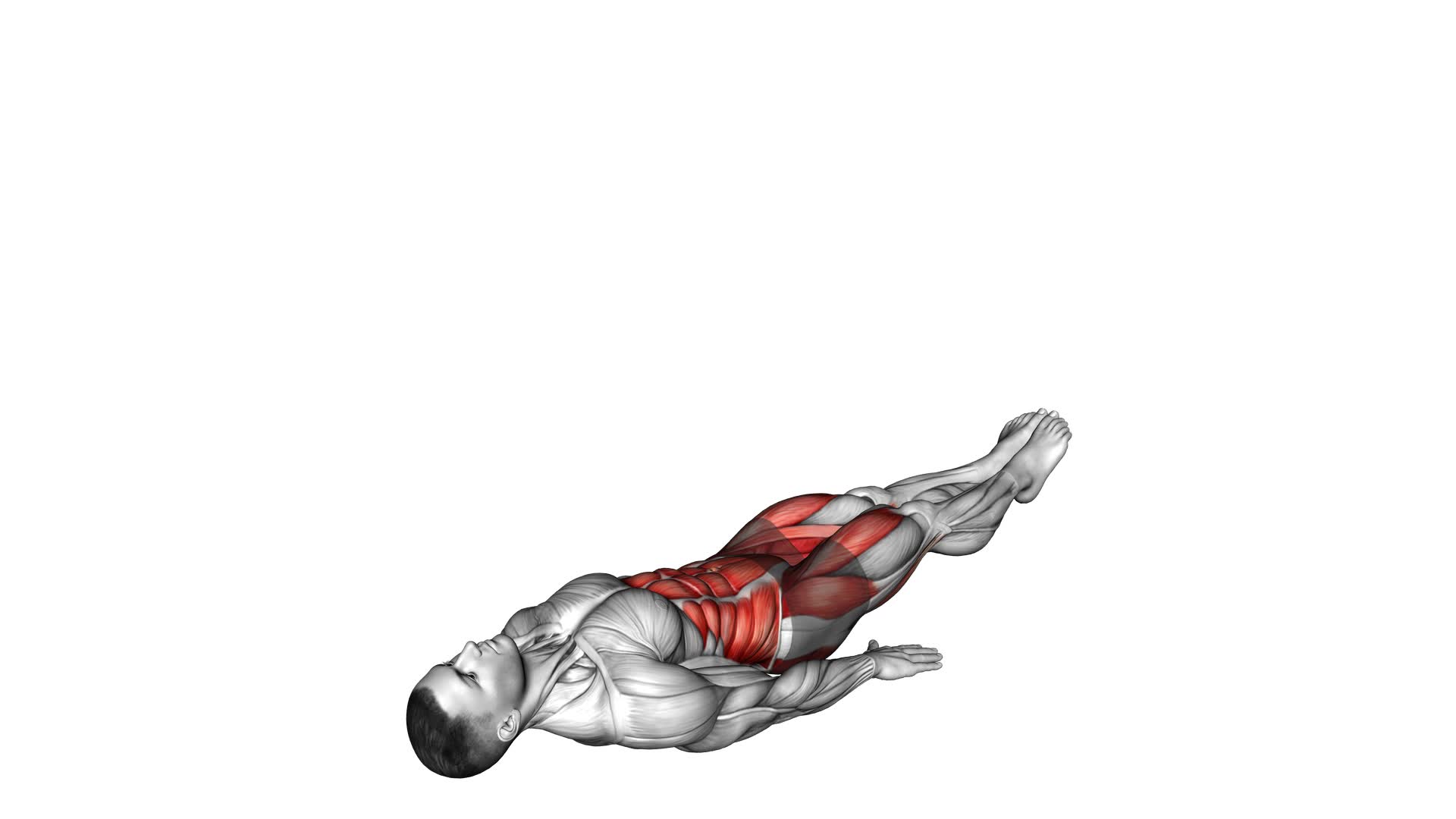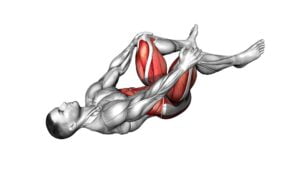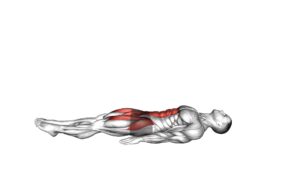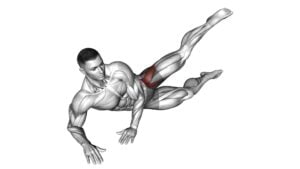Lying Leg Circle Hip Raise (male) – Video Exercise Guide & Tips

Looking to strengthen your hips and build a stronger core? Check out this quick and effective exercise guide for the Lying Leg Circle Hip Raise.
Watch This Exercise Video
In this video, we'll show you the proper form and technique, common mistakes to avoid, as well as variations and progressions to challenge yourself.
Maximize your results with these helpful tips. Get ready to feel the burn and see the benefits of this targeted exercise.
Let's get started!
Key Takeaways
- Lying Leg Circle Hip Raise can improve core strength and increase hip mobility.
- Proper form and technique, such as engaging core muscles and maintaining a pressed lower back, are essential to prevent injuries.
- Common mistakes to avoid include swinging legs, lifting legs too high or too quickly, and arching the back or lifting the pelvis off the ground.
- Variations and progressions of the exercise include single-leg hip raise, bent-knee hip raise, weighted hip raise, Swiss ball hip raise, and extended leg hip raise.
Benefits of Lying Leg Circle Hip Raise
The benefits of the lying leg circle hip raise exercise include improved core strength and hip mobility. This exercise isn't only effective for building a strong core, but it also helps prevent injuries and activates key muscles in your body. By engaging your core muscles, you can stabilize your spine and reduce the risk of back pain or injury.
The leg circle movement also requires hip mobility, which can improve your overall range of motion and flexibility.
During the lying leg circle hip raise, the muscles in your abdomen, lower back, and hips are activated. This activation helps strengthen these muscles and improves their endurance. By strengthening your core, you can also improve your posture and stability, which can translate into better performance in other exercises or activities.
In addition to injury prevention and muscle activation, the lying leg circle hip raise can also target your glutes and hamstrings. By engaging these muscles, you can enhance your lower body strength and power. This exercise is especially beneficial for athletes or individuals who participate in sports that require explosive movements, such as sprinting or jumping.
Proper Form and Technique
To perform the lying leg circle hip raise exercise with proper form and technique, position yourself on your back and engage your core muscles. Lie flat on the ground with your legs extended and arms by your sides. Keep your lower back pressed into the floor and your neck relaxed. This exercise primarily targets your abdominal muscles and hip flexors.
Common misconceptions about this exercise include using momentum to swing your legs, which can put strain on your lower back. To avoid this, focus on slow and controlled movements throughout the entire range of motion. It's important to engage your core and maintain proper form to maximize the effectiveness of the exercise and prevent injuries.
If you find this exercise too challenging, you can modify it by bending your knees and placing your feet flat on the ground. This will decrease the amount of tension on your hip flexors and make the exercise easier to perform. As you build strength and confidence, you can gradually progress to the full leg circle hip raise.
Common Mistakes to Avoid
Avoid swinging your legs or using momentum, as this can strain your lower back and detract from the effectiveness of the lying leg circle hip raise exercise.
One of the common mistakes people make isn't maintaining proper form and technique during this exercise. It's important to keep your core engaged and your lower back pressed firmly against the ground throughout the movement.
Another mistake to avoid is lifting your legs too high or too quickly. This can put unnecessary strain on your hip flexors and may lead to injury. Instead, focus on controlled movements and a full range of motion.
It's also important to avoid arching your back or lifting your pelvis off the ground. This can cause excessive strain on your lower back and reduce the effectiveness of the exercise.
Lastly, make sure to breathe properly and not hold your breath during the exercise. Proper breathing helps to engage your core and stabilize your body.
Variations and Progressions
To progress the lying leg circle hip raise exercise, you can incorporate variations that challenge your core and hip stability even further. Here are some modified exercises and advanced variations you can try:
- Modified exercises:
- Single-leg hip raise: Instead of raising both legs, try raising one leg at a time while maintaining stability and control.
- Bent-knee hip raise: Perform the exercise with your knees bent at a 90-degree angle. This variation targets your glutes and hamstrings more intensely.
- Weighted hip raise: Hold a dumbbell or a weighted plate on your hips to add resistance and increase the difficulty of the exercise.
- Swiss ball hip raise: Place a Swiss ball between your feet and perform the exercise. This challenges your stability and engages your core muscles even more.
- Advanced variations:
- Extended leg hip raise: Fully extend your legs while performing the exercise to increase the leverage and intensity on your core and hip muscles.
- Bicycle hip raise: Perform a bicycle pedaling motion with your legs while raising and lowering them. This adds a rotational component to the exercise, targeting your obliques.
- Lateral leg circle hip raise: Instead of performing circles with your legs in a forward direction, try doing them in a lateral direction. This variation engages different muscles in your hips and thighs.
- Stability ball hip raise: Place your feet on a stability ball and perform the exercise. This requires more balance and stability, challenging your core and hip muscles further.
Incorporating these modified exercises and advanced variations into your lying leg circle hip raise routine will help you progress, strengthen your core and hip stability, and make your workouts more challenging.
Tips for Maximizing Results
To maximize your results with the lying leg circle hip raise exercise, focus on maintaining proper form and engaging your core and hip muscles throughout the movement. This exercise is a great way to strengthen your lower body and improve hip mobility. Here are some tips to help you get the most out of your workout:
- Effective training strategies: Incorporate this exercise into your regular workout routine to target your glutes, hamstrings, and hip flexors. Start with a few sets of 10 repetitions and gradually increase the intensity and duration as you progress.
- Nutrition tips for muscle growth: To support muscle growth and recovery, make sure you're getting enough protein in your diet. Include lean sources of protein such as chicken, fish, tofu, or Greek yogurt. Additionally, fuel your workouts with complex carbohydrates like whole grains and fruits to provide the energy your muscles need.
Remember to listen to your body and take breaks if needed. Consistency is key, so aim to perform this exercise at least 2-3 times a week. By following these tips and staying dedicated, you'll see improvements in your strength, stability, and overall fitness level.
Frequently Asked Questions
How Many Calories Does the Lying Leg Circle Hip Raise Burn?
When you perform the lying leg circle hip raise, you can burn calories and improve flexibility. This exercise engages your core muscles and targets your hips and glutes.
By moving your legs in a circular motion while lying down, you activate various muscle groups, leading to calorie burn.
Additionally, the leg circles help to increase your range of motion and enhance flexibility in your lower body.
Can the Lying Leg Circle Hip Raise Help Improve Flexibility?
The lying leg circle hip raise is a great exercise for improving flexibility. By engaging your core and lower body muscles, this exercise helps to increase range of motion in your hips and improve overall flexibility.
If you're looking for alternative exercises to further enhance your flexibility, you can try exercises like the butterfly stretch or the seated forward bend. These exercises target different muscle groups and can offer additional benefits for improving flexibility.
Is It Normal to Feel Lower Back Discomfort While Performing the Lying Leg Circle Hip Raise?
Feeling lower back pain while doing the lying leg circle hip raise can be normal if you're not using proper form. Make sure to engage your core and maintain a neutral spine throughout the exercise.
If you're experiencing discomfort, it could be a sign of poor technique or overloading your lower back. Focus on maintaining control and using your glutes to drive the movement, rather than relying on your lower back.
Can the Lying Leg Circle Hip Raise Be Modified for Individuals With Knee or Hip Injuries?
If you have knee or hip injuries, you may need modified exercises or alternative movements for the lying leg circle hip raise. It's important to prioritize your safety and avoid aggravating your injury.
Consult with a qualified fitness professional who can guide you on suitable modifications or alternative exercises that can help you work on similar muscle groups without straining your knees or hips.
Remember to always listen to your body and make modifications as necessary.
How Frequently Should the Lying Leg Circle Hip Raise Be Incorporated Into a Workout Routine for Optimal Results?
To optimize results, incorporate the lying leg circle hip raise into your workout routine at a frequency that suits your fitness level and goals.
This exercise targets your hip and glute muscles, improving their strength and stability. Adding it to your routine a few times a week can help you develop better lower body control and enhance your overall athletic performance.
Remember to listen to your body and adjust the frequency based on your individual needs and recovery ability.
Conclusion
In conclusion, the lying leg circle hip raise is a beneficial exercise that targets the hips and core muscles. By maintaining proper form and technique, you can maximize the effectiveness of this exercise.
It's important to avoid common mistakes and gradually progress to more challenging variations. By following these tips, you can achieve optimal results and enhance your overall strength and stability.

Author
Years ago, the spark of my life’s passion ignited in my mind the moment I stepped into the local gym for the first time. The inaugural bead of perspiration, the initial endeavor, the very first surge of endorphins, and a sense of pride that washed over me post-workout marked the beginning of my deep-seated interest in strength sports, fitness, and sports nutrition. This very curiosity blossomed rapidly into a profound fascination, propelling me to earn a Master’s degree in Physical Education from the Academy of Physical Education in Krakow, followed by a Sports Manager diploma from the Jagiellonian University. My journey of growth led me to gain more specialized qualifications, such as being a certified personal trainer with a focus on sports dietetics, a lifeguard, and an instructor for wellness and corrective gymnastics. Theoretical knowledge paired seamlessly with practical experience, reinforcing my belief that the transformation of individuals under my guidance was also a reflection of my personal growth. This belief holds true even today. Each day, I strive to push the boundaries and explore new realms. These realms gently elevate me to greater heights. The unique combination of passion for my field and the continuous quest for growth fuels my drive to break new ground.







